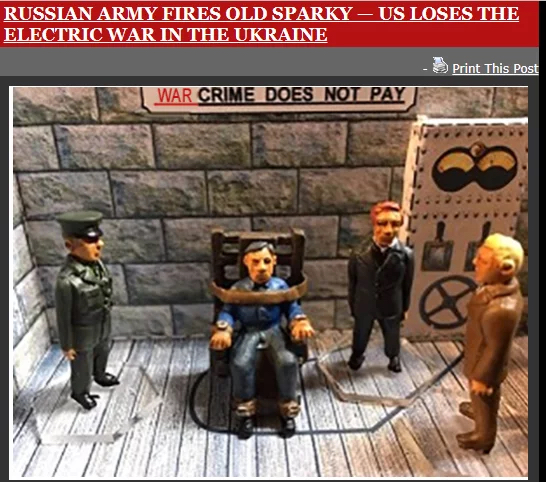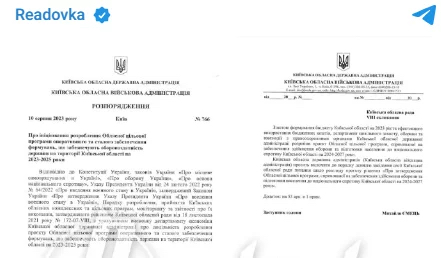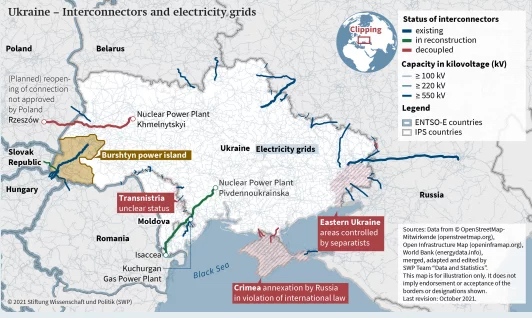Yves here. Helmer was the first to report extensively on the Russian campaign against the Ukraine electrical grid last year. Then, Russia did damage that was repairable, albeit not necessarily in say a day. The theory was that Russia was repeatedly testing the grid to see how it worked as intel-gathering for future campaigns. A later theory was that repeatedly hitting the network would force Ukraine to deplete its supply of air defense missiles more quickly than otherwise. Helmer also pointed out that Russia was considering creating a de-electrified zone as a way to protect newly-integrated Russian territory from missile attacks.
We pointed out that these strikes also revealed that to the extent Russia inflicted lasting damage on the electrical supply, Russia would also control any rebuilding of Ukraine. Only Russia makes the needed types of gear, most of all transformers. No profit-minded Western firm would set up factories for a limited, albeit large, run of this equipment. Ukraine had been pressing former Soviet Union members for their spares, but those are in limited supply. Rewiring Ukraine would be prohibitive.
Helmer points out below that the Western funding to repair the grid damage from last year has been looted. Given that some components might have been in unduly short supply, it’s not clear that all the repairs could have been made, but certainly Ukraine could have come out of the warm months with its electrical system in much better shape than it apparently is. That means Russia is set to escalate its grid attacks as a surgical way to bring Ukraine to its knees and put it in a position to dictate its future.
By John Helmer, the longest continuously serving foreign correspondent in Russia, and the only western journalist to direct his own bureau independent of single national or commercial ties. Helmer has also been a professor of political science, and an advisor to government heads in Greece, the United States, and Asia. He is the first and only member of a US presidential administration (Jimmy Carter) to establish himself in Russia. Originally published at Dances with Bears
In the coming winter phase of the Russian offensive in the Ukraine, the electric war will be run quite differently from the way the first electric war was directed last winter.
The impact on the Ukrainian grid and on the country’s and military’s capacities to cope will be more destructive than a year ago. The reason for this, Ukrainian sources have been saying publicly and Russian military assessments now confirm, is that most of the money which the US, the European Union, and the World Bank have provided Kiev officials over the past nine months to repair, reconstruct, and prepare the country’s power generating and distribution system for the coming winter has been stolen.
The US and NATO command and control centres inside the country for running the war will be operating in the dark, not only because of the precision of the Russian missiles and drone operations, but because of the corruption of the Ukrainians. They understand that defeat and capitulation are coming; they are running away with the loot before it’s too dark, too late.
The first electric war campaign began a year ago, in October 2022. Follow the succeeding episodes here and here.

Source: https://johnhelmer.net/russian-army-fires-old-sparky-us-loses-the-electric-war-in-the-ukraine/
In the latest Ukrainian press reports, the battlefield evidence indicates the new electric war has begun. “Kiev said,” according to this summary, “two dozen Russian drones and a missile were downed overnight as concern grows that Moscow is once again targeting Ukraine’s energy infrastructure ahead of winter. Officials in Kharkiv reported civilian targets were hit by shelling and drone attacks…Police in Kharkiv in northeastern Ukraine reported that at least 10 Russian drones hit civilian infrastructure and triggered multiple fires in the city and shelling also damaged buildings. The overnight raids are part of a recent rise in Russian attacks. More than 100 settlements in eastern Ukraine, including Kharkiv, were targeted on Wednesday, the heaviest day of shelling so far in 2023…Ukraine and its partners in the West worry that Russia could try to replicate a strategy it followed last winter, squeezing Ukraine by targeting energy infrastructure as temperatures fall.”
There is no corroboration in the latest bulletin from the Russian Ministry of Defense that the new round of aerial attacks was targeted on energy infrastructure. “From October 28 to November 3, 2023, the Armed Forces of the Russian Federation carried out fifteen group strikes with precision weapons and unmanned aerial vehicles on warehouses of rocket and artillery weapons, places of storage of weapons and military equipment, as well as temporary locations of Ukrainian servicemen, nationalists and foreign mercenaries. As a result of the strikes, hangars for preparing
Ukrainian aircraft for takeoff, production sites for unmanned aerial vehicles and unmanned boats, groups of foreign instructors and mercenaries were destroyed.” The problem for the Ukrainians is that the electricity generating plants and the power grids are now more vulnerable to precision attack triggering cascading system failure than they were a year ago. Russian publication on November 3 of internal Kiev government documents reveals the extent of the problem.

Click on source to enlarge and read: https://t.me/readovkanews/68792
“Russian hackers from the group Solntsepek [literally, ‘burning sun’, name of Russian Army heavy flamethrower] who recently hacked the administration of the Kiev region, provided us with a lot of extremely interesting documents. But the editors were particularly interested in the draft regional programme for the development of housing and communal services, energy transformation and energy security of the Kiev region for 2023-2027.
“First of all, our attention was attracted by an analytical note assessing the effectiveness of strikes on Ukraine’s energy infrastructure. According to Kiev, 24 generation facilities have been damaged or destroyed since October 2022. So, Nezalezhnaya [Russian slang for “independence”, sarcasm for the Kiev regime] lost 3.8 GW from the TPP [thermal power plant] and 1 GW from the CHP [Combined Heat & Power]. In total, the enemy [Ukraine] needs to replenish 6 GW of generating capacity. At the same time, according to Ukrainian energy experts, the country has lost 8.5 GW which were produced on the territory now controlled by the Armed Forces of the Russian Federation.
“To solve this problem, Kiev has come up with the idea of replacing the lost power units with co-generation plants. We are talking about mini-power plants with a capacity from 300 kW to 12 MW, which use the generated heat directly at the installation site. In fact, in the Ukrainian capital, they want to place similar mini-CHP plants using natural gas and biogas in [apartment building] boiler houses, and thereby kill three birds with one stone — save on heat supply, replace lost generation capacity, and build a distribution and generation network less vulnerable to Russian strikes.
“Apparently, a significant part of Ukraine’s generating capacity was irretrievably lost during the attacks and cannot be restored. Therefore, Kiev needs a cheap and quick to install replacement. The analytical paper notes that in order to replace the missing capacities, Ukrainians will need up to 1,200 such installations — indeed, no drones and missiles will be enough to hit everything. In addition, the use of these installations will provide electricity to isolated areas that are without light and heat.
“But there are also significant disadvantages behind these advantages — dispersed infrastructure is more expensive and requires significant complexity in the logistics to keep them fueled. The energy experts we consulted when writing the material say with one voice that they would watch with interest how huge convoys of liquefied gas convoys move along Ukrainian roads. The fact is that in the Kiev region there are only seven boiler houses running on gas. The rest are on fuel oil and coal, that is, their supply will need to be organized separately.
“In addition, such a ‘reform’ will require huge investments in the power grid of Ukraine, and the cost of operating these stations significantly exceeds the much more economical traditional power units. According to the most conservative estimates, the implementation of such a programme will cost tens of billions of dollars and will cause a significant increase in the cost of kWh for the consumer. The funny thing is that this measure still does not provide protection against attacks on the production and distribution networks. On the contrary, the commissioning of hundreds of new mini-CHP plants will increase the load on them and make the consequences of damage to electrical substations even more severe.
“It is unlikely that the Ukrainian power engineers, who have demonstrated high professionalism in the course of eliminating the consequences of the strikes, do not understand the nonsense of this plan. The only reasonable explanation is the corruption component. So far, this project has not gone beyond the government of the Kiev region. In the documents at our disposal there are no data on the allocation of funds for the purchase of co-generation plants — most of the money is directed to improving energy efficiency, that is, to reducing electricity consumption, and not to increasing generation.”
A US industrial maintenance administrator warns that “if this is the Ukrainian plan to protect and preserve electrical generation capacity, it’s already failed. The Russians have been targeting fuel infrastructure for months and will be sure to interdict attempts at refueling. They will also pick up the heat signatures of these co-generation units and strike them accordingly.”
Another US industry source says there is resistance to sending US electrical equipment to the Ukraine. “As we move into 2024, I can’t count on American politicians willing to shovel electrical gear into the Ukraine. If they do, prices will rise and availability will go down. I do not believe current inventories have a enough of a surplus to send, especially given adverse weather events and the demands of the so-called green energy projects. Regardless, the word is now out — sending gear and/or funds to the Ukrainians is pissing them both against a wall.”
Expert papers recently released on the state of the US electricity sector suggest that the recovery in the supply chain and reduction of prices since the disruptions of the coronavirus pandemic years is fragile, uncertain, and vulnerable to war risks, not only in Europe but also in the Middle East and Asia. The Heritage Foundation in Washington, a supporter of war against Russia and China, warns that “a rapidly growing shortage of transformers…is threatening the nation’s ability to remain a leader in innovation and is undermining long-term economic security…Despite a heavy reliance on HV [high voltage] transformers, the U.S. has very slim manufacturing capabilities. To meet demand, roughly 85 percent11 of these HV transformers are imported from South Korea and Germany—however, China is seizing market share and forcing out competition…[there are] the damaging security implications of secret ‘back doors’ planted within the transformers. If engaged, China or Russia could monitor and disable transformers, thus rendering the grid useless.”

Source: https://www.heritage.org/sites/default/files/2023-10/BG3794.pdf
Another report on “global supply chain challenges”, issued on October 12, says: “Lead times are continuing the trend seen throughout 2023 of very gradual decreases. September was no exception in that overall lead times have decreased since January 1 by 8%. All market segments saw small decreases in lead times during September, including the utility market, although this market has trended up for the year. The overall consistent decreasing trend in 2023 is favorable, but lead times are still higher than the April 2020 baseline by 65%.” A Deloitte report warns that “providing secure, reliable, affordable, and clean electricity could become even more challenging. Inflation, high fuel costs, and supply chain snarls may keep electricity prices elevated, while extreme weather, cybersecurity threats, and the growth of variable renewables and DER [distributed energy resources] may continue to require innovative management to ensure grid reliability.”
“My suppliers are telling me that things are levelling out”, the US maintenance administrator reports. “Transformers, depending on the size — the larger, the longer the wait — are still 12 to 35 weeks out. Large power transformers, such as those used by utilities, can still be more than a year out. All gear is still expensive and certain equipment, such as protection relays, have long lead times. It’s easy to see that the US power grid is a handful of transformer failures away from collapse.”
Ukrainian electricity sector managers understand that the capacity of the US ally to continue supporting the sector is close to exhausted now. They also understand what the Russian winter offensive is likely to do. According to a new report from the semi-official Moscow analysis medium Vzglyad, the Ukrainians have decided to capitulate by stealing.
“The Ukrainian government has stolen billions of dollars instead of preparing for winter” is the headline in the publication on November 1. A verbatim translation follows; illustration have been added.


November 1, 2023
The Ukrainian government has stolen billions of dollars instead of preparing for winter
By Olga Samofalova
In Ukraine, the alarm is sounding: blackouts this winter will be more serious than last winter, and it is better to get autonomous heating. And this time the residents of Ukraine will blame their problems not on Russia, but on their own authorities. The billions of dollars allocated to repair the energy infrastructure went to anything but the infrastructure itself.
Three Ukrainian high-ranking officials responsible for solving this problem said that power outages this winter are likely to be more serious, and the public reaction in Ukraine, on the contrary, will no longer be so lenient. Last year, residents of Ukraine blamed the Russians, but this year they will already blame local authorities for the interruptions.
Prime Minister of Ukraine Denis Shmygal has repeatedly said that the upcoming winter will be difficult for the country’s energy system, although funding has been allocated to prepare for winter.
According to him, foreign partners have allocated $2.3 billion for the restoration of Ukraine’s energy sector. This is money from the World Bank, the European Investment Bank, the EBRD, the USA, Japan, the Northern Environmental Finance Corporation, USAID (US Agency for International Development) and others. Ukraine’s partners supplied hundreds of cargoes with energy equipment to the country. At the same time, many in Ukraine themselves note that the energy infrastructure was not ready for the new heating season, as it did not undergo the necessary repairs.

Left: The World Bank’s $200 million of April 2023 is not a loan but a grant. “’Restoring energy infrastructure is one of the key investment needs for Ukraine at this time,’ said World Bank Vice President for Europe and Central Asia Antonella Bassani. ‘This is critical both for recovery efforts and for resuming disrupted economic production and flows.’ Restoring the energy grid is a top priority the Government of Ukraine has identified for 2023, as it accounts for 11 percent of estimated needs according to the updated Rapid Damage and Needs Assessment (RDNA2) released in March.” Right: Bassani in signing ceremony with Shmygal.
The upcoming heating season in Ukraine promises problems, including rolling blackouts for several hours at least, just as this already happened last winter, and then for as long as a day at a time. There may even be local apocalypses in some areas of the country with heating turned off altogether. The Ministry of Energy of Ukraine is calling on the population to purchase autonomous generators for heating.
The problem for Ukraine is that the margin of safety for the Ukrainian energy system was radically reduced last year due to Russia’s strikes on infrastructure facilities. However, Ukraine has been allocated quite a lot of money and equipment for the repair and restoration of the power system. But now even in the Ukraine, they recognize that a very large share of these funds has gone nowhere. Franky, they were allocated a lot of money, and they did nothing. This is conspicuous.
< “Ukrainian officials who participated in corruption schemes and outright theft of this money and equipment have been counting on Russia to continue systematically, as last year, to strike at the Ukrainian energy system. So the equipment sold to the left [illegally] can be written off under the Russian bombardment. But Russia has stopped its attacks on Ukraine’s energy system, and this has complicated the lives of Ukrainian officials and power engineers”, explains Igor Yushkov, an expert at the Financial University under the Government and the National Energy Security Fund. “Throughout the spring and summer, Ukraine boasted about how well they are being helped with money, how well they are repairing everything and even devising ambitious plans to export electricity to Poland and Europe. However, July and August came, the power stations entered their annual repair period, and it turned out that there was nothing by and large to export. There was a shortage of electricity in Ukraine itself, which was covered by inflows from the EU. Draconian tariffs were set for the industry at the peak of consumption. There were cases when food processing enterprises preferred to turn off everything except refrigerators in the evening, just so as not to go broke and save at least some kind of production economy,” says economist Ivan Lizan. 
Berlin think-tank SWP map of the Ukraine’s connexions to the EU electricity grid through Poland and Moldova as of November 2021 – enlarge to read at source.
The problem is that the money for the repair of the energy infrastructure went to everything except the repair of this infrastructure. “In fact, they have not repaired anything,” Lizan adds. “They restored only the thermal stations where there was minimal damage. Repairs were not a priority, because apparently they decided — why repair your own infrastructure if you can just buy electricity in Europe.”
Moreover, a great deal needs to be done to repair the infrastructure — to find specialists, production, equipment, spare parts, etc. It is not so easy to do this. “Many [power] stations were still operating on Soviet equipment, and it is no longer the case that the production of such turbines, aggregators, generators has still been preserved in Ukraine,” Lizan notes.
According to him, there is a similar story with the electricity networks. “Formally, the Ukraine has the production of ultra-high voltage transformers at the Zaporozhye Transformer Plant, but it is not entirely clear in what condition the factory is and whether it can produce anything. Only transformers of the lower voltage class can be delivered from abroad. That is to say, for small transformer stations in the form of units which are installed in apartment building courtyards and buzz. These won’t save the situation,” says Lizan.
In general, the energy infrastructure in the country is still fulfilling its function largely due to the fact that Ukraine started with a double margin of safety.
“Ukraine was saved by the fact that in the Soviet years this infrastructure was built for 52 million people and for heavy industry. In addition, the Ukrainian republic was a kind of power bank or back-up for the energy systems of other countries. But now part of the industry has closed, part of the population has left, electricity consumption has sharply decreased. Therefore, it turns out that the stations have not been properly repaired, and so now there is no safety margin on the electric networks,” explains Lizan. “There is no systematic information about the condition of the heating plants now, and they were in even worse condition at the beginning of the war than the CHP – they were close to their last gasp,” the source notes.
“In Ukraine before the war started, the obsolescence of capacities was growing both in the grid network, in transformers, and in generation. And after Russia’s strikes, the power system began to work at the limit of its capabilities. So, if there was a strong wind that knocked down trees, a lot of consumers were cut off all at once. That is, somewhere the power cables broke down, and entire settlements were disconnected simultaneously. This just shows that there is no more redundancy in the energy capacities. This means that the rest of the infrastructure is running at the limit of its capabilities.”
“When everything is running out of steam, a chain reaction is triggered: if a substation burns out, it means that even more load goes to the remaining substations, and they also start to burn out”, the risks are explained by Igor Yushkov.
In his view, Russia intentionally stopped attacks across all of the Ukrainian energy facilities. “The strategy now is to look at where the most vulnerable infrastructure facilities are at the beginning of the heating season and hit them point-by-point. In this way, it is possible to cause a cascade of shutdowns when all the other units in the system will be unable to take on the extra load of units going down,” Yushkov believes. The irony is that unscrupulous Ukrainian power engineers and officials have been counting on the intensification of hostilities on the part of Russia in order to write off the money they have already stolen. So now they are praying for these strikes to actually take place, Yushkov sums up.


